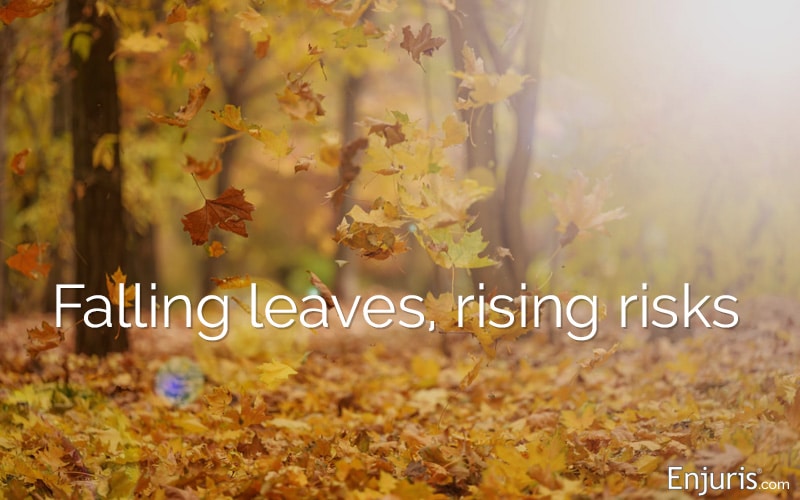
Autumn is one of the most anticipated seasons, with promises of wool sweaters, pumpkin spice lattes, and leaf-peeping adventures. But as the leaves change and the temperatures drop, this picturesque season brings with it specific risks and accidents that are not so eagerly anticipated.
For those who may be considering filing a personal injury lawsuit or simply want to be aware of the common hazards, this post outlines the most frequent autumn injuries and the legal considerations surrounding them.
Slip-and-fall accidents on wet leaves
Wet leaves can create slippery surfaces, leading to slip-and-fall accidents. You can’t hold a deciduous tree liable, but you may be able to sue a property owner for failing to keep the premises safe.
Under premises liability laws, property owners have a duty to keep their properties free from dangerous conditions.
The scope of the duty owed varies depending on how the injured person is classified. While there are slight differences among jurisdictions, the majority of states typically categorize individuals using the following classifications:
| Classification | Definition | Duty |
|---|---|---|
| Licensee | An individual who is on the premises with permission from the owner for their own convenience, curiosity, or entertainment (for example, a hunter on private property). | An owner has a duty to:
|
| Invitee | An invitee is someone who enters the property with express or implied permission for a business purpose. This could include a shopper in a retail store, a diner in a restaurant, a delivery person, or any other person who has a non-personal reason to enter a property. | An owner owes an invitee the highest degree of care, which includes:
|
| Trespasser | A person who enters a property illegally or without permission from the owner. | An owner has a duty to:
|
Hunting accidents
According to the latest survey from the United States Fish & Wildlife Service, approximately 11.5 million Americans hunt, with about ⅔ of them exclusively using firearms.
Autumn is a popular season for hunting across the country, as firearm season opens around Thanksgiving weekend in most states.
Hunting accident claims are typically based on the tort of negligence if the accident resulted from the carelessness of a fellow hunter or product liability if the accident occurred as a result of an equipment malfunction.
A Colorado jury found Ronald J. Morosko guilty of criminal negligent homicide and hunting in a careless manner in the death of bowhunter Gregory Gabrisch.
The incident occurred on September 17, 2021, when Morosko fatally shot Gabrisch, mistaking him for an elk while hunting separately in the San Juan National Forest. The prosecution argued that Morosko failed to identify his target before firing and did not follow hunter safety rules, while the defense contended that the incident was a tragic accident and did not meet the legal standard of negligence.
The four-day trial ended when the jury reached a unanimous verdict. The incident sparked discussions about hunting regulations and safety precautions.
Driving accidents in fog and rain
In many parts of the country, autumn means rainy and foggy weather, which can contribute to motor vehicle accidents.
All drivers have a duty to exercise reasonable care to avoid harming others on the road. When the weather turns poor, drivers must exercise caution by turning on their headlights and slowing their speed. If a driver fails to exercise reasonable care, they may be sued for negligence.
In the fall, the nights get longer, and longer nights allow temperatures to fall to the dew point. As the air cools, it can’t hold as much moisture, so the water vapor condenses into tiny moisture droplets that remain suspended in the air. These moisture droplets are what we call fog.
School bus accidents
Fortunately, school bus accidents are rare compared to car accidents. According to the National Highway Traffic Safety Administration (NHTSA), there were 998 fatal school bus accidents over the last decade, which means about 100 people are killed in school bus accidents every year.
Nevertheless, school bus accidents are most common in the fall.
Most school buses are owned or operated by government entities, such as school districts. This means that if you’re injured in a school bus accident, you may be filing a lawsuit against the government.
Filing a lawsuit against the government is more complicated than filing a lawsuit against a private party.
For starters, before filing the lawsuit, you must typically file a notice of claim with the appropriate government entity. This notice must include several pieces of information, including a brief description of the accident and the amount of damages sought.
Once the notice of claim is filed, you must typically wait a period of time before filing a lawsuit in court (usually 60 days). During this time, the government will review the claim and approve or deny it. If the government denies the claim, you can file your lawsuit in court.
Learn more about suing the government, including when sovereign immunity applies.
Sports-related injuries
Youth sports are extremely popular in the United States. According to a study conducted by the Sports & Fitness Industry Association (SFIA), roughly 3 out of 4 children play a team or individual sport.
Unfortunately, more than 3.5 million children get hurt every year playing sports and participating in recreational activities, according to Stanford Children’s Health Hospital.
Though not all of these injuries are serious, more than 775,000 children are treated in hospital emergency rooms for sports-related injuries each year. What’s more, sports and recreational activities contribute to approximately 21 percent of all traumatic brain injuries among children.
In most youth sports injury cases, the appropriate cause of action will be negligence. In other words, the plaintiff will need to prove:
- The defendant owed the plaintiff a duty of care. In most cases, the defendant owes the plaintiff a duty to exercise “reasonable care.” In certain situations, the defendant owes the plaintiff a more specific duty of care.
- The defendant breached the applicable duty of care. The defendant might breach the applicable duty of care by, for example, failing to remove a player from a game despite obvious signs that the player suffered a concussion.
- The plaintiff was injured as a direct result of the breach. The defendant’s breach must be the cause of the plaintiff’s injuries.
Other legal causes of action that might be appropriate in a sports injury case include:
- Product liability. A product liability claim might be appropriate if a product (such as a soccer cleat or football helmet) was defective or lacked proper warnings.
- Medical malpractice. A medical malpractice claim might be appropriate if a doctor failed to properly diagnose a condition or gave improper advice.
- Wrongful death. A wrongful death claim might be appropriate if the youth suffered a fatal injury. Wrongful death claims can be filed by certain family members of the deceased and are intended to compensate family members for the loss of a loved one.

Farming injuries
The fall harvest season brings an increase in farm-related accidents. Common types of farm injuries include:
- Machinery accidents: Tractors, combines, and other heavy machinery are common on farms, especially during the harvest season. Accidents can occur due to equipment malfunction, operator error, or lack of proper safety measures.
- Chemical exposure: Many farms use pesticides and other chemicals during the fall. Improper handling, storage, or application can lead to exposure, resulting in immediate or long-term health issues.
- Falls: Working on silos, barn roofs, or other elevated structures can lead to falls, often resulting in significant injuries.
- Animal-related injuries: Handling livestock presents risks, including being kicked, bitten, or trampled.
Employers have certain obligations under the Occupational Safety and Health Act (OSHA) to provide a safe working environment, and the failure to meet these standards can lead to legal claims.
Halloween-related injuries
From tripping over decorations to mishandling fireworks to choking on candy, Halloween presents all sorts of unique hazards.
Around this spooky season, it’s important to keep in mind that homeowners have a legal duty to ensure their property is free from dangerous conditions.
Consider the following hypothetical:
A homeowner, Michael, has decorated his front yard with a large, makeshift haunted tunnel for Halloween. The tunnel is constructed of wooden panels and covered with thick fabric. The children must walk through it to reach the front door and receive their candy.
On Halloween night, a young trick-or-treater, Laurie, enters the tunnel, and one of the poorly secured wooden panels collapses, striking Laurie and causing a serious head injury.
Laurie’s parents sue Michael on behalf of Laurie, alleging that he negligently constructed the tunnel and failed to inspect it properly.
In the above scenario, Michael may be found liable if it’s proven he was negligent in constructing and maintaining the tunnel. The court would likely analyze whether a reasonable person in Michael’s position would have foreseen the risk and taken proper precautions.
The fact that Michael opened his property to trick-or-treaters and created an attraction that invited children to enter could enhance his legal duty to ensure that the structure was safe.
Autumn brings with it specific risks that can lead to a variety of personal injuries. Understanding these common injuries and the legal principles that govern them is essential for anyone considering filing a lawsuit or taking preventive measures during the haunted season.
If you or a loved one has been injured due to any of these common autumn occurrences, consider consulting with a knowledgeable personal injury attorney to understand your legal rights and remedies. Most initial consultations are free.
Filing a Lawsuit for Psychological Injury from a Halloween Scare
Lots of people get into the Halloween spirit… but can a scare attraction go too far? Can you sue someone for a fright?

